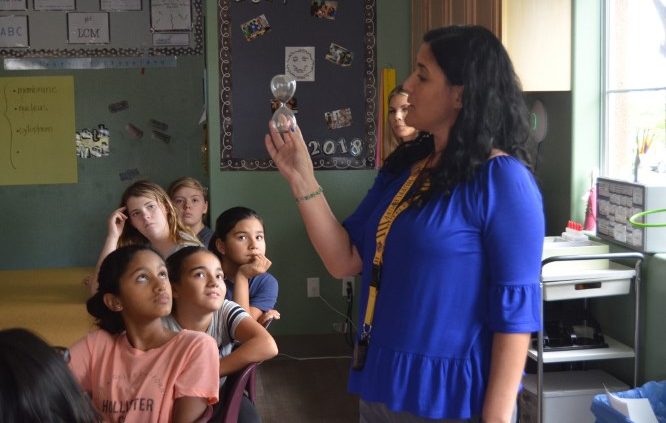Training the Mind
The FMS teaching staff began the new year with a training in mindfulness. It was given by Tessa Stephenson, MS MFT, and Regional Director for the Endeavor network. Mindfulness is an old idea getting new traction in our fast paced world. As per Ms. Stephenson, mindfulness is a perspective that cultivates “an attitude of openness and curiosity no matter the circumstances, including situations that are unwanted or unpleasant.” Mindfulness offers tools for regulating emotions in order for a person to stay present and focused in the moment they are in, instead of reacting automatically to their own emotional states.
Simply taking a deep breath can calm the mind long enough to integrate the right and left sides of the brain so a person can think clearer about the situation at hand. Many studies have shown that teaching young children mindfulness techniques gives them life skills for coping with frustrations and disappointments. The studies have also shown that as young children are taught mindfulness techniques, they begin to experience themselves moving from a reactive to a receptive state. Not only does this help them in the immediate moment where they feel challenged, but this simple training can facilitate long term positive brain development.
Integrating the left and right sides of the brain is the ideal state of mind. The right side of the brain controls senses, emotions, nonverbal communications, and gives the whole picture context. Studies demonstrate connecting with the right side of the brain where emotions are generated is critical to effectively redirecting behavior. Once the emotions are addressed, then conversation can proceed to utilizing the left side of the brain. The left side of the brain is the logical, linear, literal, and linguistic driver. Solutions can be offered and boundaries reinstated.
One of the mindful techniques brought to the classroom was a simple hand gesture. For example: holding a hand up, then folding the thumb into the palm, followed by letting the four fingers move rapidly, the child takes a breath and then slowly folds the four fingers over the thumb in a closed fist position. As the breath is being exhaled and the fingers are moving slowly over the thumb, “pull it together” is repeated silently. “Pull it together” is a verbal cue for integrating both sides of the brain. As a recent example: a primary class (ages 3-6) taught this technique to the students during a whole group circle.
During lunch that same day, a kindergartener looked at a younger peer who was having difficulty controlling their body while eating and simply held up her hand, folded her fingers over her thumb, and the other child redirected their behavior. This action was unprompted by a teacher and demonstrates the power of mindfulness.
Mindfulness and Middle School
Mindfulness is a modern term for an ancient concept of quieting the mind, intentionally. Ms. Erica introduced this concept to her middle school students this year by adding “mindfulness” as a daily part of the curriculum. She introduced mindfulness to her students by drawing their attention to their natural breathing patterns. Often, by simply putting focused attention upon the inhaling and exhaling of the breath, students began to notice a slight difference in their postures, their own breathing, and how calm they felt. A breathing ball was used to demonstrate this process.
Research done by Northwestern Medicine confirms that “nasal breathing plays a pivotal role in coordinating electrical brain signals in the olfactory “smell” cortex-the brain regions that directly receive input from our nose-which then coordinates the amygdala (which processes emotions) and the hippocampus (responsible for memory and emotions). During nasal inhalation, the fast electrical rhythms in both the amygdala and the hippocampus become stronger. The in-breath specifically alters your cognition, improving both emotional and memory processing – any slow, steady breathing like the kind employed in meditation and yoga activates the calming part of the nervous system, and slows heart rate, reducing feelings of anxiety and stress. The act of slow, deep breathing, whether the inhalation or exhalation, is beneficial for your nervous system when you wish to be more still.”1
Every midmorning, middle school students are called together to practice the art of mindfulness. Breath is always a key component to this process and is used to teach students how to tune into their mind/body connection. Ms. Erica has also found a way to reveal to her students that there is a direct link between the mind and the hands. When the mind is always active and on the go, sometimes thoughts can be tamed simply by engaging the hands in small, peaceful moments. A special shelf in the room hosts 55 different mindfulness jobs, including watching oil and water mixing in a container, tracing sand in a tray, and even trying their hands at solving the Rubik’s Cube. Students are encouraged to ground their thoughts before beginning the tasks. They are also encouraged to try various mindfulness jobs to expand their own experiences and to give others a chance to do the works. Unlike other assignments, there is no goal in mind other than to experience the process of doing the work.
Once a week, a guided meditation is done giving students the opportunity to experience the power of “being,” opposed to “doing.” Observation of the breath is the foundation of the mindfulness curriculum and is used on a daily basis. Tuning into and expanding the awareness of the five senses will take up much of the school year, with mindfulness, emotions, and the inner experience rounding out the curriculum.
During a recent class, students spent class time outside, just listening, trying to expand the reach of their sense of hearing. They were amazed to discover the variety of sounds found outside when they were quiet enough to open up their perception to the natural world. A recent survey conducted by Ms. Erica revealed the vast majority felt the class was helpful and they were enjoying it.
Mindfulness is a life skill that teaches the difference between being mindful (actively engaged in the present moment with mind, body and breath) and having a mind full of thoughts, each one racing to gain momentum over the other. With practice and awareness, students are learning to quiet their minds, balance emotions, and harness the power of their thoughts. A leading mindfulness teacher, Jon Kabat-Zinn, postulates “learning mindfulness practices in school would put people on the road to a much more healthy relationship to their body and their emotions.”2 We are seeing the truth of this statement with our middle school students. Finally, as reported by Time Special Edition, “mindfulness has been shown to increase kindness, sleep quality, behavioural control, concentration, and even math scores.”3
Mindfulness Magazine (10/2017)
1: pg. 12
2: pg. 18
Time Special Edition “The Science of Childhood” – Inside the Minds of our Younger Selves.
- Pg. 62
The Power of Observation
Observation is a foundational skill for an effective Montessori teacher. The ability to watch, listen and not interfere with a student’s learning process is essential for creating a Montessori experience. From the very beginning, Dr. Montessori (a trained physician) took the approach that teaching was not about filling a student up with facts and figures. The goal was to create an environment that was interesting and engaging while teachers introduced subject matter from the most concrete perspective, and then by extension to the abstract.
As the teacher creates and delivers specific lessons to a student, it becomes clear what parts of the lesson make sense to the student and is absorbed by them. It can be equally obvious which parts of the lesson did not resonate with the child. The skill to watch the reactions of a student and determine where the breakdown in understanding occurs is the hallmark of a Montessori educational experience.
Watching with clarity and purpose is a refined skill for a Montessori teacher. In this day of instant answers and very quick adjustments to the constant flow of information, it is tempting to step in too quickly with a student and give them the “right way of doing the lesson.” Instead, a more measured and patient approach can actually net better results. The more a student internalizes the lessons and experiences the process of manipulating the materials, or practicing more abstract skills, the greater the impact of the lesson.
Observing a student over time is also extremely helpful. Since most of the students stay in a classroom for three-year cycles, it gives the teachers a wealth of history to draw upon and to apply useful comparisons to earlier observations. Teachers’ abilities to quietly focus their listening and visual skills are the key to delivering an effective Montessori educational experience to their students.














